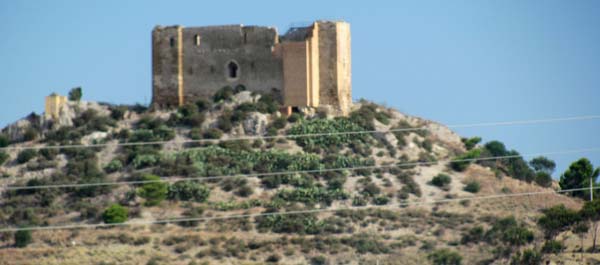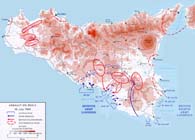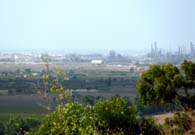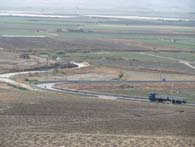A Journey to World War II Battlefields Part 4: The Airborne Battles in Sicily

Along the south coast of Sicily there are still a few traces of World War II and the battles that were fought there in 1943. A day after our trip to Malta ended we arrived for a three day visit to the island. Our initial destination was the port city of Licata, which, during the invasion, was the site of landings by Maj. Gen. Lucian K. Truscott’s 3rd Infantry Division. The primary mission of the 3rd Division was to protect the left flank of the landings at Gela by the 1st Infantry Division.
{default}The Licata mole where our cruise ship, the Corinthian II, docked was a key target on D-Day. On July 10, 1943 it was defended by an Italian railway battery and an armored train mounting four 76-mm guns, which posed a serious threat to the invasion fleet and its landing craft. On D-Day these guns were quickly knocked out by naval gunfire.
One of the first things a visitor to Sicily quickly notices is the many hundreds of hot houses that dot the landscape. The island has become an important center for growing tomatoes, melons and vegetables. Encased in bright white plastic and mostly massed in some 8,500 hectares along the south and southeast facing hillsides, they have become an important growth industry. (A hectare is defined as 10,000 square meters.)
 Our destination the first day ashore was two battlefield sites in and around the city of Gela, the key objective of the U.S. landings by Lt. Gen. George S. Patton’s Seventh Army on D-Day. The Gela landings were carried out across four beaches by the 1st Infantry Division, the Big Red One. The strongest opposition by German and Italian forces defending Sicily was expected in this sector and the events that played out on D-Day and D+1 not only confirmed that assumption but also threatened to derail the invasion.
Our destination the first day ashore was two battlefield sites in and around the city of Gela, the key objective of the U.S. landings by Lt. Gen. George S. Patton’s Seventh Army on D-Day. The Gela landings were carried out across four beaches by the 1st Infantry Division, the Big Red One. The strongest opposition by German and Italian forces defending Sicily was expected in this sector and the events that played out on D-Day and D+1 not only confirmed that assumption but also threatened to derail the invasion.
Considerable confusion occurred on the 1st Division beaches due to congestion, mines, enemy searchlights, heavy surf, trucks getting stuck in the sand, few exits from the beach and a lack of control, all of which contributed to scenes of utter chaos.
In Gela, the first Italian counterattacks on D-Day were repulsed by the infantry and by Darby’s Rangers. These counterattacks meant not only that the 1st Division would not attain its D-Day objectives but also during the first two days they would have to fight simply to retain their beachhead.
In 2010, the invasion beaches are simply not accessible. Our destination upon departing Licata by bus for Gela was the high ground to the north of the city around Ponte Olivo airfield, which in 1943 was a primary objective of the 1st Division. The entire beachhead in this sector is dominated by a hill mass upon which rests the ruins of an ancient Norman castle.
From here one can see where the airfield existed in 1943 (long since plowed over and returned to farmland), and the landing beaches. One of the Big Red One landing sites on the outskirts of Gela has become a giant oil refinery.
 The views from the castle are spectacular. Tactically, this hill dominates both the landing beaches and the key road leading north from Gela.
The views from the castle are spectacular. Tactically, this hill dominates both the landing beaches and the key road leading north from Gela.
What made Ponte Olivo so important was its proximity to and the threat it posed to the invasion beaches. Its capture and that of the high ground in and around the Norman castle would protect the beachhead and become a springboard for the advance further inland.
 From Ponte Olivo our buses made their way through the hills across the valley to National Route 115 and a visit to the site of one of the most important airborne battles of the Sicily campaign: an innocuous road junction that the Sicilians call Piano Lupo.
From Ponte Olivo our buses made their way through the hills across the valley to National Route 115 and a visit to the site of one of the most important airborne battles of the Sicily campaign: an innocuous road junction that the Sicilians call Piano Lupo.
The mission of Col. James M. Gavin’s 505th Parachute Infantry Regiment of the 82d Airborne Division was to establish blocking positions along the critical access roads leading to the vulnerable beaches. The 505th parachuted into Sicily the night before the invasion but the landings were disastrous. Only 425 of some 3,000 paratroopers of the 505th landed in front of the 1st Division on D-Day.
Operation Husky, the invasion of Sicily (See What Next General, March 2011 ACG), was the first major airborne operation of World War II and a great many lessons about its effective employment had yet to be learned. Airborne doctrine was exceedingly crude and not yet fully developed. For example, the use of pathfinders to jump first and mark the drop zones with homing devices had yet to evolve. Like Murphy’s Law, everything that could possibly go wrong with the airborne operation occurred.
The operational planning was done by officers with no airborne experience; to compound matters, the air corps transport pilots had no previous experience or training in formation flying or in dropping parachute troops.
The 226 C-47 Dakota aircraft that transported the 505th had to fly at 200 ft over the Mediterranean. Winds on the night of 9/10 July exceeded 35 mph when 15 mph was the maximum safe dropping velocity.
Many of the 505th paratroopers were torn by dysentery before departing North Africa. At take-off the dust was so thick the pilots had to perform instrument take offs. Itchy trigger fingers by Allied gunners manning the invasion fleet off shore shot at the aircraft and some paratroopers were killed before they could bail out. Pilots went off course compounding the problem of finding their DZs. Confused by smoke, enemy fire and lack of training, one C-47 landed on the main runway at Malta.
Most of the aircraft missed their turning point at Malta toward Sicily, which contributed to their failure to find their drop zones. A number of aircraft mistook Syracuse for Gela – more than a 50-mile error — while others ditched in the sea off Scoglitti. Eight were shot down by enemy fire. A great many paratroopers had to bail out at 1,500 feet at 200 mph instead of 600 feet at 100 mph. Only one of Gavin’s four battalions landed intact – and it was 25 miles east of their DZ. The unhappy result was that some 3,000 paratroopers were scattered as much as 65 miles off target.
A number of paratroopers landed in the British sector but there had been no prior coordination of call signs, nearly resulting in some friendly fire incidents. Seventy-five paratroopers landed near Avola on the east coast, a D-Day objective of the British 50th Division, and joined the British to fight. As they would later do in Normandy after the D-Day landings in June 1944 went awry, Gavin’s paratroopers nevertheless began to raise havoc all around, attacking any enemy they encountered and giving the impression of a far larger force on the ground. Before eventually joining forces with British Tommies, a group of lieutenants led a band of lightly armed paratroopers in attacking a city of 22,000.
 The most critical spot in all of Sicily on 10 July was the intersection of Rte. 115 (the main east-west highway in southern Sicily) and a highway than ran north to the towns of Casa Prioli and the hill town of Niscemi. Called Piano Lupo (plain of the wolf), it was guarded by a 16-pillbox complex along the northeast corner of the junction that secured this vital crossroads. Dubbed the “Y” by the paratroopers who had to secure this intersection in order to block German forces from counter-attacking the beachhead of the 1st and 45th Divisions, Piano Lupo became the focus of one of the two key battles during the first two days of the invasion.
The most critical spot in all of Sicily on 10 July was the intersection of Rte. 115 (the main east-west highway in southern Sicily) and a highway than ran north to the towns of Casa Prioli and the hill town of Niscemi. Called Piano Lupo (plain of the wolf), it was guarded by a 16-pillbox complex along the northeast corner of the junction that secured this vital crossroads. Dubbed the “Y” by the paratroopers who had to secure this intersection in order to block German forces from counter-attacking the beachhead of the 1st and 45th Divisions, Piano Lupo became the focus of one of the two key battles during the first two days of the invasion.
Capt. Edwin B. Sayre, the commanding officer of Co. A, 505th PIR, with about 100 men, captured this intersection on 10 July. His unit was one of the few that actually landed on D-Day on the correct DZ about three kilometers north of the “Y” at Casa Priolo. Naval gunfire had previously engaged the Italians defending this sector and when Sayre threatened to use this weapon against them they promptly surrendered. Sayre’s force moved south from Casa Priolo and captured the pillbox complex that included twenty machine guns and 500,000 rounds of ammunition, which came in very handy for an under-armed parachute force when the Germans launched their counterattack. At the “Y”, Captain Sayre joined up with elements of an infantry regiment of the 1st Division to establish a strongpoint at the pillbox complex.
A large element of the tank-heavy Hermann Göring Division was garrisoned in and around Niscemi and in a position to counterattack the Allied beachhead. Throughout 10 July Sayre’s force beat off repeated German counterattacks. Eventually, however, the German attack proved too strong and the Hermann Göring’s panzers rumbled on to Route 115 and began motoring toward Gela until naval gunfire and 1st Division artillery fire forced them to retreat. Both the paratroopers at the “Y” and the Big Red One were helped by the fact that the German counterattack was so badly coordinated that it is thought to have led to reprisals and possible executions of several of the failed German commanders.
Col. George Taylor, commander of the 16th Regimental Combat Team (later of D-Day fame on Omaha Beach) ordered two of his battalions to capture Casa Priolo and its twin Abbio Prioli early on 11 July. Accompanied by the commander of the 1/505th, twenty-seven year old LTC Arthur “Hardnose” Gorham (Gorham’s call sign), they ran headlong into a German Kamfgruppe of the Hermann Göring commencing a second day of counterattacks. A savage encounter took place as outgunned paratroopers dueled with panzers at point blank range. They managed to repel the first counterattack with artillery support and bazookas. However, the pressure was too great and the force withdrew to defend Piano Lupo with panzers in hot pursuit.
The Kamfgruppe thrust through the “Y” intersection and began moving toward Gela, coming within 1,000 meters of the Big Red One beaches before being halted by ferocious naval gunfire and the fire from four Sherman tanks of the 2nd Armored Division. At one point the fighting so close and intense that the naval guns were temporarily silenced for fear of hitting friendly forces.
By late that afternoon, with more than a third of their panzers lost, the Germans withdrew into the foothills to the north. They left behind the burning wreckage of sixteen panzers on the Gela plain, their oily black smoke a testament to what a near-run thing the battle had been.
An equally desperate battle was fought at Piano Lupo on 11 July where the 1st Division infantry and the paratroopers managed to knock out four of the six panzers that had penetrated their positions. In a similar engagement the following day, LTC Gorham was killed when he deliberately exposed himself as bait to a panzer while several bazooka teams moved in to ambush the unwary tank crew. Gorham was posthumously awarded two DSC’s for his gallantry on 10, 11 and 12 July.
Next month, the conclusion of the dramatic airborne battles in Sicily and the story of Col. Jim Gavin’s magnificent defense of Biazza Ridge.
Suggested Further Reading
Readers interested in reading further about the Sicily campaign, the airborne battles, and the battles for the Seventh Army beachheads may wish to consult the following:
Rick Atkinson, The Day of Battle: The War in Sicily and Italy, 1943-1944 (Henry Holt, 2007.)
Carlo D’Este, Bitter Victory: The Battle for Sicily, 1943 (E.P. Dutton, 1988, also available in an Aurum paperback in the UK and Harper Perennial paperback, USA.)
Albert N. Garland & Howard McGaw Smith, Sicily and the Surrender of Italy (Government Printing Office, 1965 – the official U.S. Army history of the Sicily campaign.)
Ed Ruggero, Combat Jump (HarperCollins, 2003.)


Nice article once again, but also would be nice to have large enough photographs so that we can actually see the details being described.
We are a group of between 10 to 20 people from Malta. We are interested in history and so next March we will be visiting Sicily to visit some remains especially those that has to do with Operation Husky in which Malta was also indirectly involved. Can you please send me any relevant information regarding what to visit and were are museums, remains and others situated.
Thanks